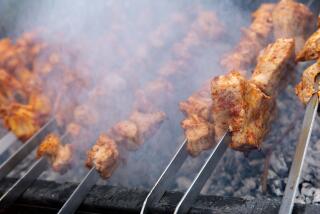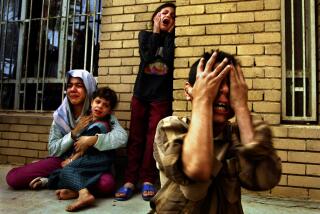Carrying a Torch for U.S. Troops
- Share via
FORWARD OPERATING BASE GABE, Iraq — Staff Sgt. Patrick Butler goes to work every day in one of the hottest places in Iraq.
Out by the dusty lots where the Army’s 2nd Battalion, 34th Armor Regiment parks its trucks and tanks is the welder’s shop, a gritty oven where Butler and his colleagues have spent much of the year sweating over better ways to protect U.S. troops.
For the record:
12:00 a.m. Sept. 25, 2005 For The Record
Los Angeles Times Sunday September 25, 2005 Home Edition Main News Part A Page 2 National Desk 0 inches; 35 words Type of Material: Correction
Soldier’s name -- An article in the Sept. 18 Section A about U.S. Army welders serving in Iraq with the 2nd Battalion, 34th Armor Regiment gave Staff Sgt. Jerry D. Theriault’s first name as Steve.
Part craftsman, part grease monkey, Butler plays a vital if sometimes overlooked role in a place where an extra panel of steel or the right weld can mean the difference between a severed limb and merely a loud thump.
“We’re kind of mavericks,” said Butler, one of the three welders attached to the 2-34, a tank battalion stationed outside Baqubah, about 35 miles northeast of Baghdad.
With thousands of soldiers killed and injured by improvised bombs on Iraqi roads, the Pentagon has faced persistent criticism that it is not adequately protecting its troops. Many of the Army’s vehicles are still only lightly armored.
At Forward Operating Base Gabe, the welders -- “my three amigos,” the battalion commander calls them -- have turned their shop into an armor laboratory and help-desk for soldiers seeking answers to questions such as how to repair a tank or where to find a car part back home.
Steel plates cut in various shapes and sizes are scattered on workbenches next to canisters of oxygen and argon gas. In one corner of the shop, designs for armor plates are scrawled on a whiteboard. Two bullet-riddled plates the welders had tested at the shooting range lean on a pillar nearby.
“They do amazing work,” said their commander, Capt. Paul Deegan, 31, a metallurgist from Longmont, Colo., who shows off photos of his 1956 Buick and knows the best junkyard near the unit’s home base in Kansas.
In addition to its life-and-death work, the team has welded intricate designs on the base gates and built a firetruck, and is working on a rowing machine for the gym. “With this job, you get asked to build a barbecue grill or two,” said Butler, a 37-year-old Reading, Pa., native who has been an Army welder for 16 years.
The unofficial chief of the welding crew is Staff Sgt. Steve Theriault, or Sgt. T., as he is known in the Army, where complicated last names are usually reduced to their first letter.
Theriault, 36, who joined the service out of high school back in Connecticut, is known around the shop as the master craftsman, a welder who can shape a piece of metal into a work of art to adorn an armor-plated 5-ton truck.
“T can take a drawing and turn it into something like no one I’ve ever seen,” said Butler, who, like Theriault, became an Army welder after high school. “I’m more of a blacksmith. I like to heat a piece of metal and bend it and twist it and make it mine.”
Spc. Lester Jackson, a 27-year-old Kansas City, Kan., native, is the team’s junior man. “He just gets beat up,” Butler said of his colleague. “T tells him one thing. I tell him another. It’s like a Jedi thing.”
For a while, they were also joined by 12-year-old Irman, an Iraqi boy who used to come to the base with a relative who did laundry for the battalion.
“Within three weeks, we had him welding,” Butler said fondly, recalling that Irman took to the work with such gusto that the welders had to hold him back from trying to use all the shop’s tools and gadgets.
Irman had to be told to leave after he was caught stealing. “I still miss him sometimes,” Butler said.
Welding is dirty, sweaty work in a place where summer temperatures reach 130 degrees and a welding mask can make it feel like 160. “I tell people if they can weld in Iraq, they can weld anywhere,” said Theriault, standing by a garbage can overflowing with empty water and Gatorade bottles.
The team has been busy nearly every day since the battalion arrived in Kuwait and then drove north to Baqubah in February. It has added plating to Humvees and strengthened the protection around gun turrets on many of the battalion’s transport trucks.
The pride of the workshop is the “Team Truck,” a flatbed the welders covered with plating and outfitted with a roof, custom-built folding steps and Humvee seats to transport troops going home on leave.
On the back of the truck, Theriault added meticulously crafted sabers and a spade, the logos of two units in the battalion that have suffered casualties.
On this day, Theriault, Butler and Jackson are busy on their latest project, cutting steel plates to install in two lightweight Russian jeeps they are armoring for the Iraqi army.
Theriault designed a scheme for one, and Deegan, who studied metallurgy at the Colorado School of Mines, has worked up a plan for the other. “We’ve got a little bit of a competition going,” Theriault said.
The quality of the vehicles doesn’t impress any of the welders. But they keep cutting.
“Anything I can do to keep the medics out of business is good for me,” Butler said. “That’s kind of my mantra this year.”
More to Read
Sign up for Essential California
The most important California stories and recommendations in your inbox every morning.
You may occasionally receive promotional content from the Los Angeles Times.














